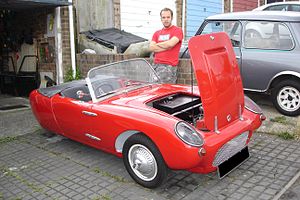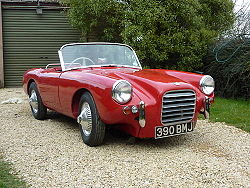BERKELEY CARS
were produced between October 1956 and December 1960 by Berkeley Coachworks at their Hitchin Street, Biggleswade factory in Bedfordshire.
Designed by Laurie Bond of Minicar fame, the original Berkeley “Sports” introduced in 1956 was a lightweight two-seat sports car powered by a 322cc Anzani two-stroke twin producing 15 bhp. Initial difficulties with supply and performance resulted in a change in January 1957 to the Excelsior Talisman Twin two-stroke of 328cc, with a 20% increase in power to 18bhp.
The car was unique at the time of its launch in that it employed not only a transverse engine and front wheel drive, but a complete fibreglass monocoque hull reinforced locally by lightweight aluminium sections. Endowed with exceptional road holding by virtue of its all independant suspension and low centre of gravity, superb handling and braking, public demand, particularly from America resulted in a search for a more powerful engine. The Excelsior MotorCycle Company supplied the answer in the form of a 492cc three-cylinder version of the Talisman. With over 30 Bhp available to propel 6’12 cwt, performance now matched the looks of the car. The car could now cover the quarter mile in 22.4 seconds.
In an attempt to expand the appeal of the Berkeley a four-seat version, achieved by lengthening and widening the basic shell, was introduced and called the Foursome. Although powered by the same 492cc engine that was proving very popular, the Foursome failed to attract the buyers and only 17 were built.
Although around 2,500 four-wheeled Berkeley’s were produced by far the most well remembered, and now most common version, was the three-wheeled T60. Conceived as a basic model and employing the 328cc Talisman twin engine, the T60 was an overnight success and held great appeal for the ex-motorcyclist looking for car type transport powered by an engine/transmission he was familiar with. A 2+2 version the T60/4 was developed for the small family and was launched in September 1960.
Throughout their short career Berkeley’s built up an enviable reputation in the field of competition. On rallies, driving tests and full-blown racing circuits the little Berkeley’s defied all attempts by the handicappers to keep them from the front. Superb brakes, leech-like roadholding and chuckable handling ensured what they lost on the straights they rapidly made up on the corners. International recognition came from the string of successes achieved by Count “Johnny” Lurani’s team of 492 cc cars at Verona, Monza and in the Mille Miglia.
Financial pressure from unsympathetic banks, economic unease and credit restrictions were to combine to bring this once highly successful caravan concern to an end.
The Bandit, an altogether more conventional vehicle employing a steel chassis and a Ford Anglia engine but retaining all of Berkeley’s reputation for performance pointed the way for the future. Sadly it came too late to save the firm. Only two prototypes were produced of a car which, given a little time and development, could have assured continuing success for Berkeley cars.

Berkeley B95 and B105

The B95 and B105 models were launched at the 1959 Geneva Motor Show and boasted more power from twin-cylinder Royal Enfield 692 cc four-stroke engines, with the 40 bhp (30 kW; 41 PS) Super Meteor engine in the B95 and the 50 bhp (37 kW; 51 PS) Constellation unit in the B105 which could reputedly exceed the magic 100 mph (160 km/h). The engines featured Berkeley-design primary chain cases to accommodate a Bendix starter motor, and duplex (or double-row) chain drive to the differential. Kerb weight increased to 402 kg (890 lb). B95 engine numbers have the unique prefix 'SMTB', while B105 engines are prefixed 'SMUA'.
The prototype car was SE492 chassis number 638, which was modified to add bracing to withstand the extra power and weight of the four-stroke engine, a taller bonnet (US hood) with large grille to accommodate the engine, and unfaired headlights. In mid-February 1959 this car spent two weeks at the Royal Enfield factory, during which time it covered 500 miles of general road use and 1,000 mi (1,600 km) of endurance testing at MIRA.
By the time of the press release announcing the launch of the B95 in March 1959, a further 2,500 mi (4,000 km) of road and track tests had also been carried out by Berkeley factory drivers. Perhaps to address the reputation for breaking down that the two-strokes had developed, especially in export markets, it was emphasised by the factory that during this testing there had been no involuntary stops or any form of mechanical failure, and that further testing would be performed until a total of 15,000 mi (24,000 km) had been completed.
At its launch, the B95 cost £659 (equivalent to £11.4 thousand today). About 200 B95 and B105 models were made, with chassis numbers following-on from the SE492 series and chassis number 670 (the earliest known B95) was registered at the end of March 1959. The first B105, chassis number 686, was delivered about one month later.
About half of the four-stroke cars were exported, and both the B95 and B105 were in production at the time the company was declared insolvent in December 1960.
QB95 and QB105
n October 1959 the Q range was announced, with longer and wider bodies the same dimensions as the Foursome. The wheelbase went up from 70 inches (1,800 mm) to 78 inches (2,000 mm) and the track from 42 inches (1,100 mm) to 46 inches (1,200 mm). The Qs were four seaters (just), although the QB version dispensed with the rear seat to give extra luggage space. The only 'official' mention comes from the "Autocar" Motor Show edition of October 1959, when it appears that Berkeley's stand featured a red soft-top QB95 and a blue QB105 with a black hard-top. From this single reference it is assumed that Berkeley built at least two models of this series, although no original cars are known to survive.

The B95 and B105 models were launched at the 1959 Geneva Motor Show and boasted more power from twin-cylinder Royal Enfield 692 cc four-stroke engines, with the 40 bhp (30 kW; 41 PS) Super Meteor engine in the B95 and the 50 bhp (37 kW; 51 PS) Constellation unit in the B105 which could reputedly exceed the magic 100 mph (160 km/h). The engines featured Berkeley-design primary chain cases to accommodate a Bendix starter motor, and duplex (or double-row) chain drive to the differential. Kerb weight increased to 402 kg (890 lb). B95 engine numbers have the unique prefix 'SMTB', while B105 engines are prefixed 'SMUA'.
The prototype car was SE492 chassis number 638, which was modified to add bracing to withstand the extra power and weight of the four-stroke engine, a taller bonnet (US hood) with large grille to accommodate the engine, and unfaired headlights. In mid-February 1959 this car spent two weeks at the Royal Enfield factory, during which time it covered 500 miles of general road use and 1,000 mi (1,600 km) of endurance testing at MIRA.
By the time of the press release announcing the launch of the B95 in March 1959, a further 2,500 mi (4,000 km) of road and track tests had also been carried out by Berkeley factory drivers. Perhaps to address the reputation for breaking down that the two-strokes had developed, especially in export markets, it was emphasised by the factory that during this testing there had been no involuntary stops or any form of mechanical failure, and that further testing would be performed until a total of 15,000 mi (24,000 km) had been completed.
At its launch, the B95 cost £659 (equivalent to £11.4 thousand today). About 200 B95 and B105 models were made, with chassis numbers following-on from the SE492 series and chassis number 670 (the earliest known B95) was registered at the end of March 1959. The first B105, chassis number 686, was delivered about one month later.
About half of the four-stroke cars were exported, and both the B95 and B105 were in production at the time the company was declared insolvent in December 1960.
QB95 and QB105
n October 1959 the Q range was announced, with longer and wider bodies the same dimensions as the Foursome. The wheelbase went up from 70 inches (1,800 mm) to 78 inches (2,000 mm) and the track from 42 inches (1,100 mm) to 46 inches (1,200 mm). The Qs were four seaters (just), although the QB version dispensed with the rear seat to give extra luggage space. The only 'official' mention comes from the "Autocar" Motor Show edition of October 1959, when it appears that Berkeley's stand featured a red soft-top QB95 and a blue QB105 with a black hard-top. From this single reference it is assumed that Berkeley built at least two models of this series, although no original cars are known to survive.
| Production | 1959 2 approx produced. |
|---|---|
| Body style | 2-door roadster |
| Engine | 692 cc transverse four stroke twin, air-cooled |
| Wheelbase | 78 in (1,981.2 mm) |
| Length | 133.5 in (3,390 mm) |
| Width | 54 in (1,371.6 mm) |
| Height | 46 in (1,168.4 mm) |




















![1909 Torpedo V4 Replica [ VIDEO ] 1909 Torpedo V4 Replica [ VIDEO ]](https://blogger.googleusercontent.com/img/b/R29vZ2xl/AVvXsEgfdPjZpZUJV1SztVbrzWsoYN-hXirKx2EKwbvj6yV1F9MCOJBIqDQk5X7NwONJDrmFV6djQ3HeogaYlmcSUNXJcHmh060uo4D8ec3ErqhnQX488lc3LDXNS3zpIboYgH2CRaX1PySc34M/w75-h75-p-k-no-nu/torpedo-v4-leftside.jpg)

